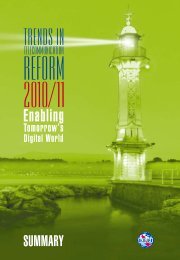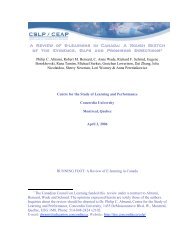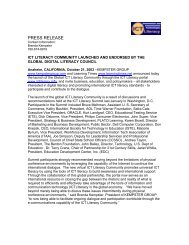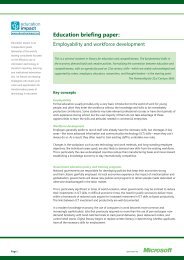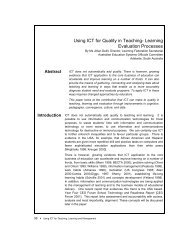147 pages pdf - ICT Digital Literacy
147 pages pdf - ICT Digital Literacy
147 pages pdf - ICT Digital Literacy
Create successful ePaper yourself
Turn your PDF publications into a flip-book with our unique Google optimized e-Paper software.
Content, Content (Not To Mention Content) … How To Best Design & Deliver It<br />
#281: Make It Easier On Yourself<br />
Use Style Sheets when developing to make updates easier.<br />
Kathy Lents<br />
HouseHold International, Inc.<br />
#282: From Incorrect to Correct, Show Me<br />
In WBT or in simulations, consider how incorrect user actions are processed. Most products I've seen merely<br />
tell you you're wrong. Depending upon learner style and level of mastery needed, maybe the error isn't<br />
immediately detected and the WBT lets you continue but the error is discovered later. Maybe the WBT lets<br />
you know you made a mistake, and then asks you how to correct the error. The same information sets up a<br />
flag to present the points that were missed during the final summary.<br />
Tom Swider<br />
#283: Avoiding The Graphics & Animation Trap<br />
When preparing e-Learning content, graphics and animations are not the first things that you<br />
should think of. Study the content in a very detailed way to determine the concepts that should<br />
be given to the user. Then decide which concepts can be supported by which graphics and<br />
animations (or not). Graphics and animations that have no effect on the learning quality of the<br />
user experience add no value to the e-Learning content.<br />
Aysenur T. Akman<br />
Oyak Technology<br />
#284: Activity, Not Passivity<br />
Be clear on the distinction between education and entertainment and know your audience. So<br />
called "Edutainment" may be fine for children but is unlikely to satisfy adults. As the NY Times<br />
has reported, "TV isn't teaching" and this applies particularly to adults. Bottom line: Don't teach<br />
"down" to adults in an attempt to entertain them.<br />
Wendell Laidley<br />
New Media Learning LLC<br />
#285: Test Placement Matters<br />
For required training, include a "no fault" test immediately after the module and a graded test<br />
after completion of all modules.<br />
Perry E. D'Antonio<br />
Sandia National Laboratories<br />
#286: Design Prescriptions<br />
Develop to the lowest common denominator of your audience. This includes elements such as color choice<br />
("web-safe" colors), text size, screen resolution, etc. Especially with text, try to use CSS stylesheets to more<br />
closely assure consistency and your desired output. And be sure to include some type of interactivity every<br />
few <strong>pages</strong> to avoid just a "page-turner," even if it is just having the user rollover an image or text to get more<br />
information or to move forward. Instant feedback "what do you think's" are great to insert throughout a<br />
module. These don't have to include scoring, they are just spot checks for the user.<br />
Mario Cruz<br />
John Hancock Financial Services, Inc.<br />
#287: Think Small<br />
Our e-Learners don't have a long attention span or much time for learning at their desks. Try to<br />
keep the learning modules below 20 minutes in length (usually 9-15 slides).<br />
Patricia Nicholson<br />
Sun Life Financial<br />
701 e-Learning Tips by The MASIE Center www.masie.com 57






